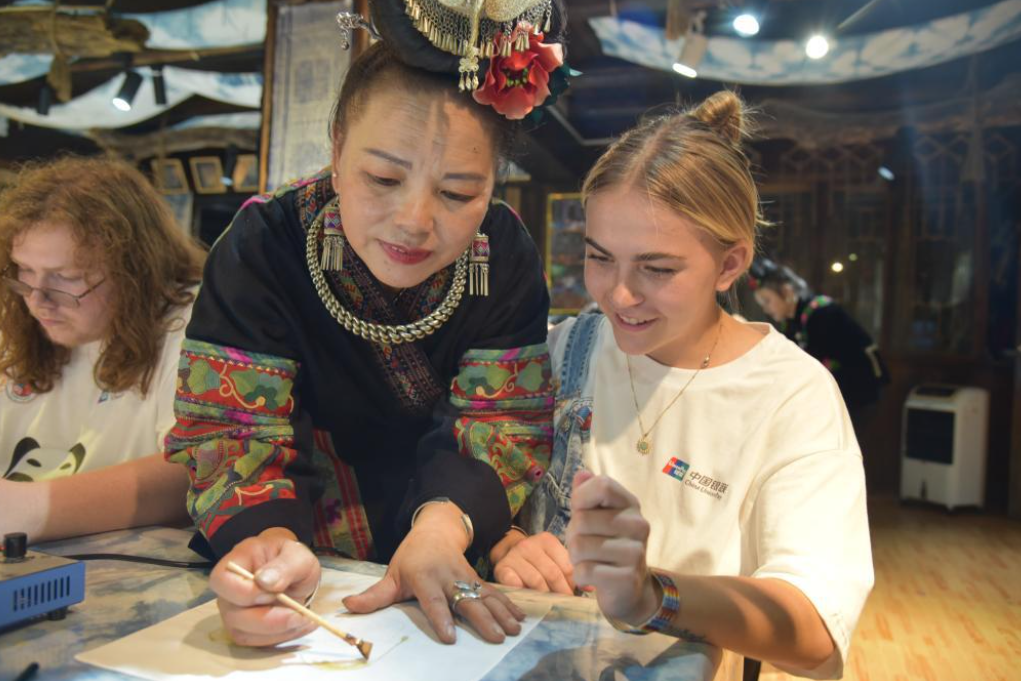
During the Mid-Autumn Festival holiday, the stilt house of Li Wenfang, a Miao woman, is very busy. A group of teenagers from the United States are sitting together, carefully following her batik making skills.
"First, you have to use a pen to trace the pattern on the white cloth, and then use a wax knife to evenly trace the melted wax, so that the wax and the pattern fit together." Li Wenfang, dressed in Miao costume, demonstrates and explains.
Kenzie Thompson Shelton, a graduate of Lakewood High School, studied hard. The first time she experienced batik production, she felt that with a wax knife as a pen, it was not easy to draw evenly on white cloth.
Though still unskilled, Shelton patiently sketched the giant panda. She said: "Wax oil is easy to set on the white cloth, a little careless clumping, and some small lines can not be completed with a wax knife, need to be carefully painted."
There were also 80 teachers and students from Lincoln Middle School and other schools in Washington State.
At the invitation of the Chinese People's Association for Friendship with Foreign Countries, they participated in the "Youth Walk" delegation from Washington State organized by the US-China Youth Student Exchange Association to visit Guizhou, China, and experienced the intangible cultural heritage in Qianhu Miao Village, Xijiang.
Guizhou Province, located in the hinterland of southwest China, is a multi-ethnic region. For thousands of years, Miao, Dong, Buyi and other people have lived here, creating a rich and colorful national culture. Miao batik technique is one of the most distinctive national arts.
Miao batik technique is to use wax to draw patterns on natural fibers such as hemp, silk, cotton and wool, and then immerse them in an indigo dye VAT.
When the wax melts, it presents a blue and white "ice pattern" with an abstract sense, which is mainly used for printing and dyeing traditional ethnic costumes.
The skill was included in the first batch of national intangible cultural heritage list in 2006, and has been well inherited and protected.
Wu Mingyu, 16, a Miao student, sits among them, learning batik techniques with American teenagers. Ms. Wu, who grew up steeped in Miao culture, is a skilled operator and occasionally helps her American students.
After listening carefully to the teacher's explanation, Kenneth Klein from Tri-City Preparatory High School in Washington State, United States, boldly innovated, using a wax knife to sketch a brave warrior holding a long sword and wearing armor.
Klein clutched his batik masterpiece and couldn't wait to show it to reporters.
"Look, I've drawn a mighty warrior!" 'he said with an excited look on his face. Creative, he skillfully combines the cultural elements he has always loved with his newly learned Miao batik technique.Beautiful and elegant "friendship flower", naive "giant panda", unrestrained "abstract painting"...... The ancient art of batik has taken on a different face in the hands of imaginative young people in China and the United States.
Many interviewed American students said that they did not expect to use Miao batik techniques to express such rich and personalized patterns, which is really a wonderful national cultural experience.
At the scene, a number of Miao students from the second grade of Kaili No. 1 Middle School introduced Miao embroidery, silver jewelry, festivals, food and other cultures to the American teenagers on this trip.
At this moment, the Miao traditional stilted house where Li Wenfang and his family live is like a vivid intangible cultural heritage class, building a platform for Chinese and American youth to communicate about the experience and inheritance of Chinese national culture.

